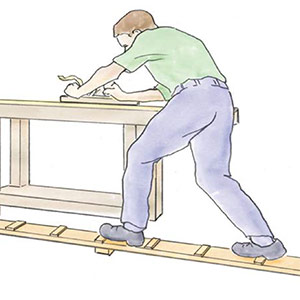Setting Up Shop
Three pros give advice on outfitting a first shop
Synopsis: Peter Korn, Mario Rodriguez, and Mark Duginske recommend different tools that woodworkers need to set up a good basic furniture woodworking shop. Workshops are individual, but there’s a common thread of sense in what they offer. Korn advises that machinery and hand tools are complementary aspects of a contemporary workshop; Rodriguez suggests going heavy on quality hand tools, with a few select power tools, and Duginske talks about starting off with inexpensive tools that allow you to get the job done, as opposed to too few high-end tools that leave you stuck. Each expert lists the makes and models of the tools he recommends.
What tools do you need to set up a good basic shop to make functional furnishings you can be proud of? That’s the question I posed to three accomplished woodworkers—and teachers of woodworking. Independently, each affirmed the importance of both accurate, reliable power tools and high-quality hand tools in the modern woodworking shop. Though sometimes contradictory, the advice they offer is surprisingly consistent. And where it varies it’s often because of their different backgrounds and the kinds of work they do.
Peter Korn was a professional furnituremaker for 12 years and taught furniture design at Drexel University for four of those years before becoming director of the woodworking program at Anderson Ranch Arts Center in 1986. He has written numerous magazine articles and newspaper columns on woodworking, and his book, Working with Wood: The Basics of Craftsmanship, was published by The Taunton Press in April. Korn left Anderson Ranch last December to start his own woodworking school, the Center for Furniture Craftsmanship, which is in Hope, Maine. The school offers two-week courses for basic and intermediate woodworkers.
Mario Rodriguez is a cabinetmaker and 18th-century woodworking consultant. He’s been making 18th- and 19th-century reproductions for the past 12 years, specializing in Windsor chairs. He has been adjunct assistant professor of woodworking for the Fashion Institute of Technology’s antique restoration program for the past five years and has lectured at the Brooklyn Museum, the Cooper-Hewitt Museum, Sotheby’s, the Royal Oak Society and for other groups interested in Early American woodworking. He also teaches at Warwick Country Workshops in Warwick, N.Y. Subjects taught have included planemaking and use, dovetailing and veneering.
Mark Duginske, a contributing editor to Fine Woodworking, is a fourth-generation woodworker. His books include The Band Saw Handbook, Rand Saw Basics, The Band Saw Pattern Book, Precision Machinery Techniques and most recently, Mastering Woodworking Machines, which was published by The Taunton Press last year. He has also done two videos, one accompanying his most recent book and the other called Mastering Your Bandsaw. His restoration work on the Frank Lloyd Wright home and studio in Oak Park, Ill. has been featured on This Old House and PBS’s Frank Lloyd Wright special.
From Fine Woodworking #100
For the full article, download the PDF below:
Fine Woodworking Recommended Products

WoodRiver Router Bit Storage Case

Woodriver Rechargeable Desiccant Bag






















Log in or create an account to post a comment.
Sign up Log in